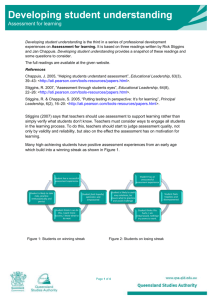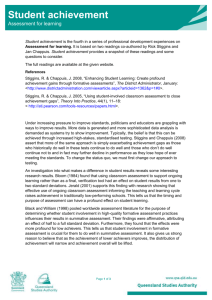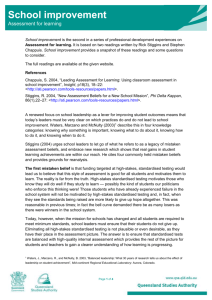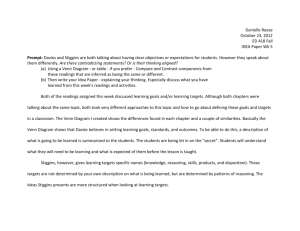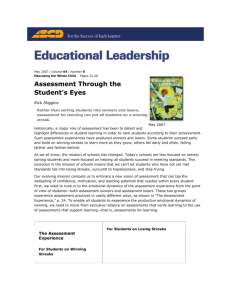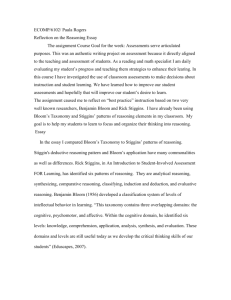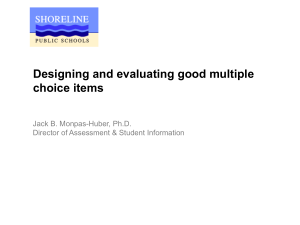Overview of Learning Targets
advertisement
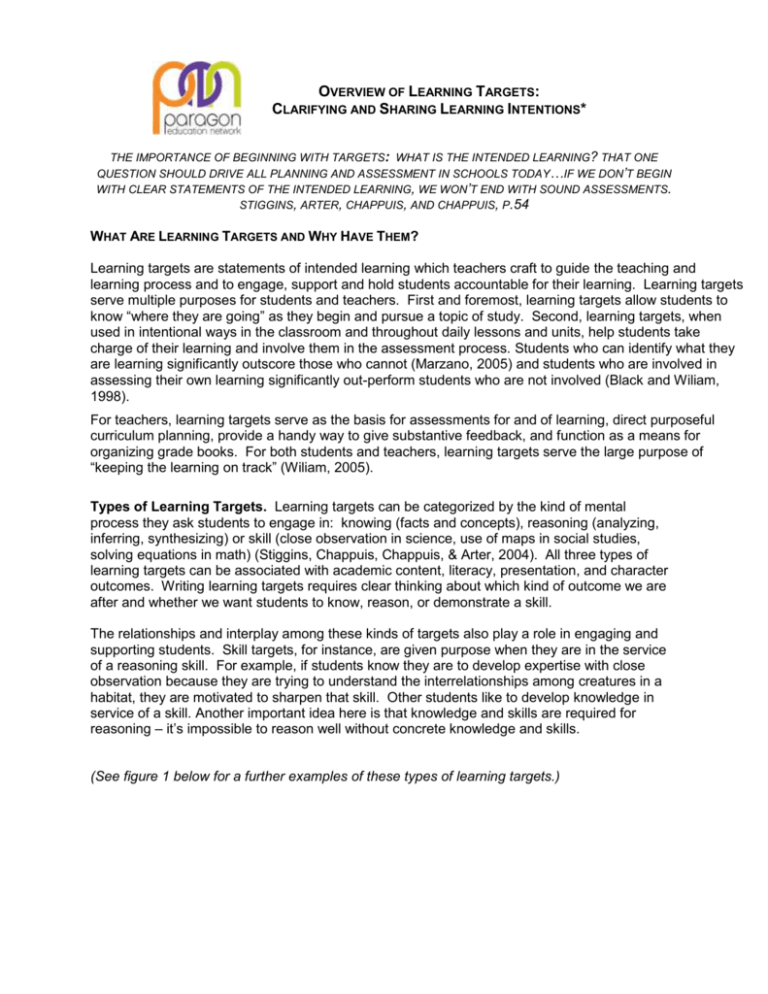
OVERVIEW OF LEARNING TARGETS: CLARIFYING AND SHARING LEARNING INTENTIONS* THE IMPORTANCE OF BEGINNING WITH TARGETS: WHAT IS THE INTENDED LEARNING? THAT ONE QUESTION SHOULD DRIVE ALL PLANNING AND ASSESSMENT IN SCHOOLS TODAY…IF WE DON’T BEGIN WITH CLEAR STATEMENTS OF THE INTENDED LEARNING, WE WON’T END WITH SOUND ASSESSMENTS. STIGGINS, ARTER, CHAPPUIS, AND CHAPPUIS, P.54 WHAT ARE LEARNING TARGETS AND WHY HAVE THEM? Learning targets are statements of intended learning which teachers craft to guide the teaching and learning process and to engage, support and hold students accountable for their learning. Learning targets serve multiple purposes for students and teachers. First and foremost, learning targets allow students to know “where they are going” as they begin and pursue a topic of study. Second, learning targets, when used in intentional ways in the classroom and throughout daily lessons and units, help students take charge of their learning and involve them in the assessment process. Students who can identify what they are learning significantly outscore those who cannot (Marzano, 2005) and students who are involved in assessing their own learning significantly out-perform students who are not involved (Black and Wiliam, 1998). For teachers, learning targets serve as the basis for assessments for and of learning, direct purposeful curriculum planning, provide a handy way to give substantive feedback, and function as a means for organizing grade books. For both students and teachers, learning targets serve the large purpose of “keeping the learning on track” (Wiliam, 2005). Types of Learning Targets. Learning targets can be categorized by the kind of mental process they ask students to engage in: knowing (facts and concepts), reasoning (analyzing, inferring, synthesizing) or skill (close observation in science, use of maps in social studies, solving equations in math) (Stiggins, Chappuis, Chappuis, & Arter, 2004). All three types of learning targets can be associated with academic content, literacy, presentation, and character outcomes. Writing learning targets requires clear thinking about which kind of outcome we are after and whether we want students to know, reason, or demonstrate a skill. The relationships and interplay among these kinds of targets also play a role in engaging and supporting students. Skill targets, for instance, are given purpose when they are in the service of a reasoning skill. For example, if students know they are to develop expertise with close observation because they are trying to understand the interrelationships among creatures in a habitat, they are motivated to sharpen that skill. Other students like to develop knowledge in service of a skill. Another important idea here is that knowledge and skills are required for reasoning – it’s impossible to reason well without concrete knowledge and skills. (See figure 1 below for a further examples of these types of learning targets.) Figure 1: Types of Learning Targets Target Type Knowledge Explanation Knowledge, facts and concepts to be learned outright or retrieved from reference materials Reasoning Thinking proficiencies – using knowledge to solve a problem, make a decision, plan, etc. Skills Behavioral demonstrations; using knowledge and reasoning to perform skillfully Examples Vocabulary Measurement concepts U.S. government structure Patterns of growth and development Think critically Analyze authors’ use of language Solve problems Compare forms of government Analyze health information Read fluently Oral presentations Play an instrument Use laboratory equipment Conduct investigations From Stiggins, Arter, Chappuiss and Chappuis, 2004, p. 64 Figure 2: Key Verbs for Learning Targets Knowledge Define, identify, explain, label, list, locate, match, recall, state, tell, name, describe, paraphrase, sequence, categorize, classify, specify, choose, select Reasoning Interpret, analyze, compare, contrast, debate, conclude, formulate, generate, appraise, justify, defend, deduce, induce, infer, diagnose, differentiate, infer, dissect, formulate, evaluate, transfer, connect, synthesize, draw conclusions, critique, prove, judge Skills Apply, compute, build, demonstrate, draw, illustrate, diagram, operate, show, reconstruct, convert, model, dramatize, conduct, perform, measure, investigate, collect, observe, create, design, write, compose, express Culled from Stiggins (2004), Bloom, Shepard (2005) WHAT ARE QUALITIES OF EFFECTIVE LEARNIG TARGETS? Learning targets are almost always linked to or based on standards (national, state or district). The Assessment Training Institute (ATI) points out that standards or unit objectives can sometimes serve directly as clear learning targets, but they often need to be “deconstructed” to describe the intended learning in language that is student friendly and contextually specific. Student-friendly language: Although used by teachers to direct the planning process, to create assessments of learning (summative assessments), and to guide feedback, learning targets are written with the learner as the intended audience. ATI instituted the practice of starting learning targets with the stem “I can…” The use of this stem is powerful for several reasons. First, the stem implicitly lets students know they are capable of achieving the learning that the target names – that the learning is within their grasp. Second, the use of the first person makes it personal and about them. Contrast, “I can…” with the impersonal “The student will…” format of many standards. The latter stem may indeed make students feel like the statement concerns some other student but certainly not them. Thus, the very wording and first person pronoun format of a learning target puts students in charge of their learning. Another defining feature of learning targets is that they are written in language that is accessible to students. This means, that as students mature, learning targets become increasingly sophisticated. Take, for example, the following science learning targets: I can describe the life cycle of the dragonfly. I can identify the simple machines used in a bicycle. I can explain why carbon sits where it does in the periodic table. I can analyze the role of genetic mutation in influenza epidemics. While learning targets become increasingly sophisticated as students mature, they provide, at any age, an opportunity to build academic vocabulary for subject area content. Since learning targets always include a strong, active verb that connotes some aspect of what it means to know, reason, or use a skill, verb choices used in learning targets provide another good source of academic vocabulary for students and useful synonyms for cognitive processes. These verbs also specify what students need to do to show their learning (e.g., identify, explain, analyze, etc.) or make it visible to others. For that reason, verbs such as “understand” do not work well in learning targets. (See figure 2 above for further examples.) Contextualized vs. Generalized Targets: Many learning targets are contextualized to the particular topic under study. Note in the above examples of learning targets that they all refer to a particular context – dragonflies, bicycles, flu epidemics. There are several reasons for contextualizing targets. One reason is that students have an easier time understanding the target if it is linked to the topic under study. Another reason is that contextualized learning targets feel more reachable than abstract, generalized targets. For example, compare the generalized version to the contextualized version: “I can describe life cycles” to “I can describe the life cycle of the dragonfly.” Or, “I can analyze the role of genetic mutation in evolution” vs. “I can analyze the role of genetic mutation in influenza epidemics.” It should be noted, however, that there is a role for generalization targets. Eventually, students should be able to compare and contrast the life cycles of different creatures and generalize to the nature and processes of the life cycle, and, in high school, analyze the role of genetic mutation in evolution. Studying a big concept in a specific context is a great first step towards achieving a generalization target. Another good reason to contextualize targets is that some learning targets refer to ongoing processes that are never finally mastered. Targets that belong in this category include ones about inferring, synthesizing, comparing and contrasting, etc. “I can infer” is meaningless unless the student knows what to infer about: character motivation? Or, reasons for trends in data? WHERE DO LEARNING TARGETS COME FROM? Learning targets, are, for the most part, derived from standards. However, there are other sources of targets itemized below: Local, state, or national standards School or district curriculum maps or skills continuums Reading, writing, math or other program materials School-developed character traits and codes of conduct Essential questions or big ideas for curriculum units Skills and understandings associated with a final product or performance medium (e.g., a mural or reader’s theatre) The following table shows an example of standards deconstructed into student-friendly and contextualized learning targets: Standard Algebra Functions 1.1 use variables and appropriate operations to write an equation, an inequality, or system of equations or inequalities that represents a verbal description. History SS3.4 analyze how human settlement patterns create cooperation and conflict which influence the division and control of the Earth (e.g., treaties, economics, exploration, borders, religion, exploitation, water rights). Health H5.1 identify problem-solving processes specific to health-related issues. Science Sc 3.4 explain the interdependent nature of biological systems in the environment and how they are affected by human interaction. Learning Target I can write an expression from a written statement. I can analyze the impact of the Hellgate Treaty on the Confederated Salish Kootenai Tribe. I can identify the eating habits that can lead to obesity. I can analyze the impact our wildfire management decisions have on the health of the forest ecosystem. Long-term and supporting learning targets: Learning targets can describe the intended learning over a long period of time such as a course, a trimester, or a six-week unit. Or, they can describe shorter term goals for a lesson, a set of lessons, or for a particular learning experience. When learning targets are written to express the intended learning over a long period of time, we refer to those targets as long-term learning targets. When a target describes the intended learning for a short period of time, we call this kind of target a supporting learning target, as it is one step toward attaining a long-term learning target. In other words, supporting targets are scaffolds to long term targets. These smaller, supporting targets provide day to day direction because they are specific and concrete; students can use them to stay focused and measure their progress towards the more general and sophisticated long-term targets. Long-term targets intrigue students because they give students something ambitious to work towards; supporting targets engage students because there is pay-off every day in terms of being able to reach these more accessible targets and make progress towards the long-term ones. Reaching supporting targets in service of long-term targets is a momentum builder. It is helpful to explain to students how supporting targets connect to the long-term targets. For example, how a learning target for that day’s lesson plan connects to a key learning target for the unit. Connecting supporting targets to long-term targets gives purpose to each lesson, makes learning targets come alive in the classroom, and engages students in the assessment process. Creating a visual of the relationship between supporting targets and long-term targets further reinforces the connection. Long-term target I can model how non-diabetic and diabetic people metabolize glucose. (Reasoning) Supporting targets I can analyze the role of Manifest Destiny in Westward Expansion. (Reasoning) I can explain sugars, lipids, and proteins and the role each play in the body. I can explain how insulin gets into cells. I can model two ways people with Type 2 Diabetes metabolize glucose. I can explain the concept of homeostasis as it relates to the body’s use of glucose. I can explain economic factors involved in manifest destiny I can explain the religious factors involved in manifest destiny I can explain the governmental factors involved in manifest destiny I can explain the romantic and personal factors involved in manifest destiny Conclusion Using learning targets has far-reaching consequences for teaching and learning. The process of crafting learning targets helps teachers take standards that are often convoluted and general and to figure out precisely what learning they are after. Learning targets provide a logical basis for creating high quality assessments of learning and can be used to organize grade books (instead of organizing grade books by tests). However, the most significant consequences of learning targets depend on how they are used in the classroom. When class time is spent making learning targets clear and understandable, when criteria for meeting targets is crystal clear, and when they are used to involve students in assessing their own and their peers’ learning, learning targets become instrumental in empowering students to take charge of their learning. *This overview is based on the work of ATI (Stiggins, Arter, Chappuis, Chappuis), Dylan Wiliams (and the Assessment for Learning Group), and the work of teachers from the Oakland Unified School District, Portland Public Schools, Missoula County Public Schools, and the Odyssey School in Denver, References: Black, P. and Wiliam, D. (1998). Inside the Black Box: Raising Standards through Classroom Assessment. Phi Delta Kappan, Vol. 80 (2). Leahy, S., Lyon, C., Thompson, M. & Wiliam, D. (2005). Classroom Assessment: Minute by Minute, Day by Day. Educational Leadership, Vol. 63, #3, pp.19-24. Marzano, R. (2005). What works in schools (PowerPoint presentation). Available: www.marzanoandassociates.com/pdf/ShortVersion.pdf Shepard, L. (2005). Linking Formative Assessment to Scaffolding. Educational Leadership, Vol. 63, #3, pp. 66-70. Stiggins, R.; Arter, J.; Chappuis, J. & Chappuis, S. (2004). Classroom Assessment for Learning: Doing it Right - Using it Well. Princeton, NJ: ETS.
